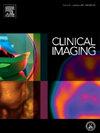I saw the “hourglass” sign: CT diagnosis of inguinoscrotal bladder herniation with pseudo-diverticula
IF 1.5
4区 医学
Q3 RADIOLOGY, NUCLEAR MEDICINE & MEDICAL IMAGING
引用次数: 0
Abstract
Bladder herniation into the inguinoscrotal region is an uncommon condition that can present with lower urinary tract symptoms and scrotal swelling. Early recognition is critical to avoid serious complications during surgical repair. We report a case of a 75-year-old man with a history of multiple left inguinal hernia repairs who presented with urinary urgency, urge incontinence, and hematuria. Physical examination revealed a persistent scrotal mass. Contrast-enhanced computed tomography (CT) showed a cystic lesion within the left scrotum, directly communicating with the urinary bladder. Delayed-phase images demonstrated progressive opacification of the herniated bladder segment, resembling an “hourglass” configuration. Pseudo-diverticula were also observed within the herniated portion, suggesting chronic bladder outlet obstruction. Given symptom improvement and surgical history, the patient opted for conservative management. This case highlights the importance of recognizing the “Hourglass” sign on CT imaging as a diagnostic clue for inguinoscrotal bladder hernias, aiding early diagnosis and preventing intraoperative complications.
我看到“沙漏征”:CT诊断腹股沟阴囊膀胱疝伴假性憩室
膀胱疝入腹股沟阴囊区是一种罕见的情况,可表现为下尿路症状和阴囊肿胀。早期识别对于避免手术修复过程中的严重并发症至关重要。我们报告一例75岁男性,有多次左侧腹股沟疝修补史,表现为尿急、急迫性尿失禁和血尿。体格检查发现一个持续的阴囊肿块。增强计算机断层扫描(CT)显示左侧阴囊内有囊性病变,与膀胱直接相连。延迟期图像显示膀胱疝段渐进性混浊,类似“沙漏”形态。假性憩室也可见于疝出部分,提示慢性膀胱出口梗阻。鉴于症状改善和手术史,患者选择保守治疗。本病例强调了在CT图像上识别“沙漏”征作为腹股沟-阴囊膀胱疝的诊断线索,有助于早期诊断和预防术中并发症的重要性。
本文章由计算机程序翻译,如有差异,请以英文原文为准。
求助全文
约1分钟内获得全文
求助全文
来源期刊

Clinical Imaging
医学-核医学
CiteScore
4.60
自引率
0.00%
发文量
265
审稿时长
35 days
期刊介绍:
The mission of Clinical Imaging is to publish, in a timely manner, the very best radiology research from the United States and around the world with special attention to the impact of medical imaging on patient care. The journal''s publications cover all imaging modalities, radiology issues related to patients, policy and practice improvements, and clinically-oriented imaging physics and informatics. The journal is a valuable resource for practicing radiologists, radiologists-in-training and other clinicians with an interest in imaging. Papers are carefully peer-reviewed and selected by our experienced subject editors who are leading experts spanning the range of imaging sub-specialties, which include:
-Body Imaging-
Breast Imaging-
Cardiothoracic Imaging-
Imaging Physics and Informatics-
Molecular Imaging and Nuclear Medicine-
Musculoskeletal and Emergency Imaging-
Neuroradiology-
Practice, Policy & Education-
Pediatric Imaging-
Vascular and Interventional Radiology
 求助内容:
求助内容: 应助结果提醒方式:
应助结果提醒方式:


